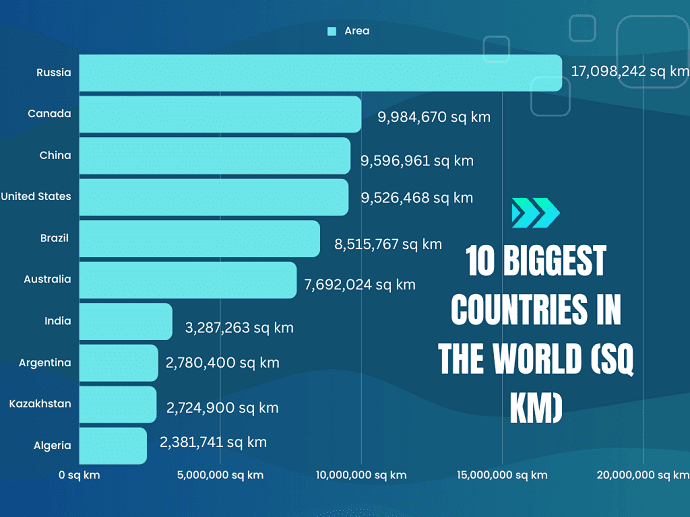The world is a vast and diverse place, with countries spanning every corner of the globe. Some are small and densely populated, while others are expansive and sparsely inhabited. Here we will take a look at the 10 biggest countries in the world by land area: Russia, Canada, China, the United States, Brazil, Australia, India, Argentina, Kazakhstan,and Algeria.
List of the 10 biggest countries in the world
Russia, the biggest country in the world
17,098,242 sq km
Russia is the largest country in the world by a significant margin, covering more than 11% of the Earth’s land area. It has a population of more than 144 million people. Russia contains a wealth of natural resources, including oil, gas, minerals, and timber.
Russia spans 11 time zones and two continents – Asia and Europe.
Geographical features
The vast Siberian taiga dominates the Russian landscape. It is a massive forested region that covers over 5 million square kilometers. This region is home to a wide variety of wildlife, including brown bears, elk, wolves, and Siberian tigers.
In the north, Russia is bordered by the Arctic Ocean. The region includes the expansive Arctic tundra, characterized by low temperatures and permafrost. It has an unique ecosystem adapted to the harsh conditions. The Arctic region is home to many indigenous peoples including the Nenets, Evenki, and Chukchi peoples.
To the south, Russia is bordered by the Caucasus Mountains. The range runs from the Black Sea to the Caspian Sea, and includes the highest peak in Europe, Mount Elbrus. The region is famous for its natural beauty, with deep canyons, stunning waterfalls, and unique flora and fauna.
The Ural Mountains, a range that runs from the Arctic Ocean to the Caspian Sea, separate European Russia from Asian Russia. The mountains are known for their rich mineral deposits. These minerals include iron, copper, and gold. The region is home to several major cities, including Yekaterinburg and Chelyabinsk.
Russia has some of the world’s largest rivers and lakes including Volga and Baikal. The Volga River is the longest river in Europe, and Lake Baikal is the deepest lake in the world. Lake Baikal is also one of the world’s largest freshwater lakes. It has unique flora and fauna, including the Baikal seal, which you can find nowhere else on earth.
Canada
9,984,670 sq km
Canada is the second-largest country in the world and spans six time zones. Canada is famous for its diverse landscapes, including mountains, forests, and vast stretches of tundra. Although it is the second best country to live in the world only 38 million people live in the country.
Canada is larger than both the European Union and Australia combined.
Canada is located in North America, stretching from the Atlantic Ocean in the east to the Pacific Ocean in the west, and northward to the Arctic Ocean.
Geographical features
Canada has a diverse range of geographical features that make it one of the most unique and picturesque countries in the world. From the majestic Rocky Mountains to the rugged coastlines of the Maritimes, Canada offers a wealth of natural wonders.
The Canadian Shield, a vast area of Precambrian rock, covers almost half of the country. It is home to a variety of wildlife, including caribou, moose, and bears. The region is also dotted with thousands of lakes and rivers, making it a popular destination for outdoor enthusiasts.
The Rocky Mountains, which run through western Canada, offer some of the most stunning scenery in the country. The towering peaks, glacier-fed lakes, and alpine meadows attract hikers, skiers, and nature lovers from around the world. Banff National Park and Jasper National Park are two of the most popular destinations in the region.
To the east, the Canadian Shield gives way to the rolling hills and fertile valleys of the Great Lakes-St. Lawrence Lowlands, which is the most populous region of Canada. This area includes cities such as Toronto, Montreal, and Ottawa. It is home to some of the country’s most iconic landmarks, such as the CN Tower and Parliament Hill.
The eastern coast of Canada is characterized by rugged coastlines, stunning beaches, and picturesque fishing villages. The Bay of Fundy, located between New Brunswick and Nova Scotia, is home to the world’s highest tides, which can rise and fall by as much as 16 meters. The region is also known for its fresh seafood and delicious cuisine.
The Arctic region of Canada, which covers a vast area of the country, is home to a unique ecosystem adapted to the harsh conditions. The region is also home to the Inuit and other Indigenous peoples. They have lived in the area for thousands of years and have developed their own distinct cultures and traditions.
China
9,596,961 sq km
China is the third-largest country in the world. Located in East Asia, it is home to a diverse range of geographical features, from towering mountains and arid deserts to lush forests and fertile river valleys. China is also second-most populous country in the world.
One of China’s most iconic features is the Great Wall, a series of fortifications that stretches for over 13,000 miles across the country’s northern border. The wall was constructed over several centuries and is one of the most impressive engineering feats in human history.
Geographical features
China is home to some of the world’s tallest and most spectacular mountain ranges, including the Himalayas, the Kunlun Mountains, and the Tian Shan Mountains. The Himalayas, which straddle the border between China and Nepal, include the world’s tallest peak, Mount Everest, and attract mountaineers and adventurers from around the world.
In addition to its mountain ranges, China is also home to vast deserts, including the Gobi Desert and the Taklamakan Desert, which cover large parts of the country’s northwestern region. These deserts are home to unique flora and fauna, including the Bactrian camel and the elusive snow leopard.
The Yangtze River, which runs for over 6,000 kilometers, is the longest river in Asia and the third-longest in the world. It flows through some of China’s most beautiful and fertile regions, including the famous Three Gorges, which offer stunning views of towering cliffs and cascading waterfalls.
China is also known for its vast grasslands, which cover large parts of the country’s north and west. These grasslands are home to a variety of wildlife, including the iconic giant panda, which is found only in China’s Sichuan, Shaanxi, and Gansu provinces.
United States, 4th-biggest country in the world
9,526,468 sq km
The United States of America is the fourth-largest country in the world. It is also the most powerful country and the strongest economy in the world. The US is located in North America and is home to a wide range of geographical features, from towering mountain ranges and sprawling deserts to verdant forests and lush wetlands.
Geographical features
One of the most iconic features of the United States is the Grand Canyon, a massive gorge carved by the Colorado River in the state of Arizona. The canyon is over 277 miles long and up to 18 miles wide in some places, offering visitors stunning views of towering rock formations and dramatic cliffs.
The Rocky Mountains, which run through western North America, are another notable feature of the United States. The range includes some of the highest peaks in North America, including Mount Elbert in Colorado and Mount Rainier in Washington. The Rockies offer spectacular views of snow-capped peaks, alpine meadows, and crystal-clear lakes.
To the east of the Rockies, the Great Plains stretch for hundreds of miles, covering large parts of the central United States. The region is characterized by vast open spaces, rolling hills, and fertile farmland, making it an important agricultural region for the country.
The United States is also home to several iconic natural wonders, including Yellowstone National Park, which was the world’s first national park and is home to a wide range of wildlife, including bison, elk, and grizzly bears. Yosemite National Park, located in California, is famous for its towering waterfalls, granite cliffs, and ancient sequoia trees.
The country’s eastern coast is characterized by a mix of rugged coastlines, sandy beaches, and bustling cities. The Atlantic Ocean is home to some of the country’s most famous landmarks, such as the Statue of Liberty in New York Harbor and the Kennedy Space Center in Florida.
In addition to its natural wonders, the United States is known for its diverse cultural heritage and iconic cities, such as New York, Los Angeles, and Chicago. Each city has its own unique character and attractions, from the bright lights of Times Square in New York to the glitz and glamour of Hollywood in Los Angeles.
Brazil
8,515,767 sq km
Brazil is the fifth-largest country in the world and spans four time zones. It is home to more than 213 million people. The country has diverse landscapes including the Amazon rainforest, beaches, and mountains.
Geographical features
The Amazon Rainforest, which covers over 60% of Brazil’s land area, is the largest rainforest in the world and is home to a staggering array of plant and animal species. The Amazon River, which runs through the heart of the rainforest, is the second-longest river in the world and is a lifeline for millions of people and animals.
The Brazilian Highlands, located in the country’s central and eastern regions, are a vast mountainous region that includes some of the highest peaks in Brazil, such as Pico da Bandeira and Pico das Agulhas Negras. The region is also home to stunning waterfalls, including the world-famous Iguazu Falls, which straddle the border between Brazil and Argentina.
Brazil is also home to the world-famous Pantanal, a vast wetland area that is home to a diverse array of wildlife, including jaguars, caimans, and capybaras. The region is a paradise for birdwatchers, with over 650 species of birds recorded in the area.
The Brazilian coastline is over 7,400 kilometers long and is home to some of the world’s most beautiful beaches, including Copacabana and Ipanema in Rio de Janeiro and Praia do Forte in Bahia. The coast is also dotted with stunning natural landmarks, such as the towering cliffs of Morro Branco and the rock formations of Fernando de Noronha.
Brazil’s diverse geography has also given rise to a rich and vibrant culture, with unique music, dance, and cuisine that reflect the country’s rich history and diverse ethnic makeup. From the samba rhythms of Rio de Janeiro to the spicy flavors of Bahian cuisine, Brazil’s cultural offerings are as diverse and exciting as its natural wonders.
Australia
7,692,024 sq km
Australia is the sixth-largest country in the world and spans three time zones. It is home to more than 25 million people. It can boast of its unique wildlife, including kangaroos and koalas, as well as its vast deserts and rugged coastlines.
Geographical features
One of the most iconic natural features of Australia is Uluru, also known as Ayers Rock, a massive sandstone monolith located in the heart of the country’s red center. Uluru is sacred to the local Indigenous Anangu people and is a popular destination for visitors seeking to witness its stunning colors during sunrise and sunset.
The Great Barrier Reef, located off the coast of Queensland, is the world’s largest coral reef system and is home to an incredible variety of marine life. It stretches for over 2,300 kilometers and is a popular destination for snorkelers and scuba divers from around the world.
Australia’s rugged coastline is home to some of the world’s most beautiful beaches, such as Bondi Beach in Sydney and Cable Beach in Western Australia. The coast is also home to stunning natural landmarks, such as the Twelve Apostles in Victoria and the Great Ocean Road, a scenic coastal drive that winds through Victoria and South Australia.
The Australian Outback, located in the country’s central and western regions, is a vast desert wilderness that covers over 70% of the country’s land area. It is home to unique wildlife, such as kangaroos and wallabies, and features stunning geological formations, such as the Kata Tjuta rock formations and the Bungle Bungle Range.
Australia’s eastern coastline is home to lush rainforests, such as the Daintree Rainforest in Queensland, and stunning mountain ranges, such as the Blue Mountains in New South Wales. The Snowy Mountains, located in southeastern Australia, are the highest mountain range on the continent and are popular for skiing and other winter sports.
India
3,287,263 sq km
India is the seventh-largest country in the world and is home to more than 1.3 billion people. It spans three time zones and is known for its diverse landscapes, including the Himalayas, deserts, and tropical forests.
Geographical features
The Himalayan mountain range, which runs along India’s northern border, is the highest mountain range in the world and includes some of the highest peaks, such as Mount Everest and Kanchenjunga. The region is home to a unique culture and a variety of rare and endangered species, including the elusive snow leopard.
The Indo-Gangetic Plain, which extends across northern and eastern India, is one of the most fertile regions in the world and is home to over 40% of the country’s population. The region is known for its rich agricultural traditions, and its rivers, such as the Ganges and the Brahmaputra, are considered sacred by many Hindus.
The Deccan Plateau, located in southern India, is a vast elevated region that includes many important cultural and historical sites, such as the ancient city of Hampi and the Ajanta and Ellora Caves. The region is also home to a wide range of flora and fauna, including tigers, elephants, and sloth bears.
India’s coastline is over 7,500 kilometers long and is home to some of the world’s most beautiful beaches, such as Goa and Kerala. The coast is also home to stunning natural landmarks, such as the famous rock formations of Mahabalipuram and the impressive sea caves of Elephanta Island.
India’s diverse geography has also given rise to a rich and vibrant culture, with unique music, dance, and cuisine that reflect the country’s rich history and diverse ethnic makeup. From the classical music of the north to the spicy flavors of southern cuisine, India’s cultural offerings are as diverse and exciting as its natural wonders.
Argentina
2,780,400 sq km
Argentina is the eighth-largest country in the world and spans three time zones. It is home to more than 44 million people. Its diverse landscapes include the Andes mountains, grassy plains, and glaciers.
Geographical features
The Andes Mountains, which run along Argentina’s western border, are the highest mountain range outside of Asia and include many important cultural and historical sites, such as the ancient Inca trail and the stunning Lake District. The region is also home to a wide range of unique wildlife, including condors, llamas, and vicuñas.
The Pampas, which extend across central Argentina, are a vast and fertile grassland region that is home to some of the world’s most renowned beef cattle. The region is also popular for its gaucho culture, which celebrates the traditional way of life of the Argentine cowboys.
Argentina’s coastline is over 4,800 kilometers long and includes many stunning beaches, such as Mar del Plata and Pinamar. The coast is also home to the Valdes Peninsula, a UNESCO World Heritage Site that is known for its unique marine wildlife, including southern right whales and Magellanic penguins.
The country’s interior is home to many important cultural and historical sites, such as the ancient ruins of the Jesuit missions and the impressive Iguazu Falls, which straddle the border between Argentina and Brazil. The region is also home to the stunning Quebrada de Humahuaca, a colorful canyon that is home to many indigenous communities.
Argentina’s diverse geography has also given rise to a rich and vibrant culture, with unique music, dance, and cuisine that reflect the country’s rich history and diverse ethnic makeup. From the tango music and dance of Buenos Aires to the rich flavors of Argentine cuisine, the country’s cultural offerings are as diverse and exciting as its natural wonders.
Kazakhstan
2,724,900 sq km
Kazakhstan is the ninth-largest country in the world and spans four time zones. It is home to more than 19 million people. The country has vast steppes, deserts, and mountain ranges.
Geographical features
The Tien Shan Mountains, which run along Kazakhstan’s southern border, are some of the highest and most spectacular mountains in the world. The region is famous for its stunning natural beauty, with towering peaks, deep valleys, and pristine alpine lakes. The region is also home to a rich diversity of flora and fauna, including rare snow leopards, argali sheep, and golden eagles.
The vast steppe grasslands of Kazakhstan stretch across much of the country’s central and northern regions. This region is flat and open terrain and is home to some of the world’s largest grasslands, such as the Kazakh Steppe. The region is also home to many important cultural and historical sites, such as the ancient city of Turkestan and the unique “singing dunes” of Altyn Emel National Park.
Kazakhstan is also home to many important bodies of water, such as the Caspian Sea, the Aral Sea, and the Irtysh and Ishim rivers. The country’s rivers provide important water resources for agriculture and industry, while its lakes and seas are home to a rich diversity of aquatic life, including sturgeon, salmon, and other fish species.
The country’s diverse geography has also given rise to a rich and vibrant culture, with unique music, dance, and cuisine that reflect the country’s rich history and diverse ethnic makeup. From the traditional folk music of the Kazakh people to the rich flavors of Kazakh cuisine, the country’s cultural offerings are as diverse and exciting as its natural wonders.
Algeria
2,381,741 sq km
Algeria is the tenth-largest country in the world and spans one time zone. It is home to more than 43 million people and is prominent for its diverse landscapes, including the Sahara desert, mountains, and coastlines.
Geographical features
The Atlas Mountains, which run along Algeria’s northern border, are the largest mountain range in North Africa. The region is famous for its stunning natural beauty, with towering peaks, deep valleys, and pristine alpine lakes. The region is also home to a rich diversity of flora and fauna, including the endangered Barbary macaque and the African golden wolf.
The vast Sahara Desert covers much of Algeria’s southern and eastern regions. This arid, desert terrain is home to some of the world’s largest sand dunes, such as the famous Grand Erg . Despite its harsh conditions, the Sahara is home to a surprising array of wildlife, including desert foxes, sand cats, and the rare Saharan cheetah.
Algeria is also home to many important bodies of water, such as the Mediterranean Sea, the Atlas Mountains’ rivers, and the Tassili n’Ajjer Plateau’s lakes.
From the traditional Berber music and dance to the rich flavors of Algerian cuisine, the country’s cultural offerings are as diverse and exciting as its natural wonders.
Summary of the 10 biggest countries in the world
The 10 biggest countries in the world by land area, including Russia, Canada, China, the United States, Brazil, Australia, India, Argentina, Kazakhstan, and Algeria. These countries home to a vast array of cultures, languages, and landscapes. They offer a glimpse into the diversity of our planet and the many ways in which we can experience and explore it.








